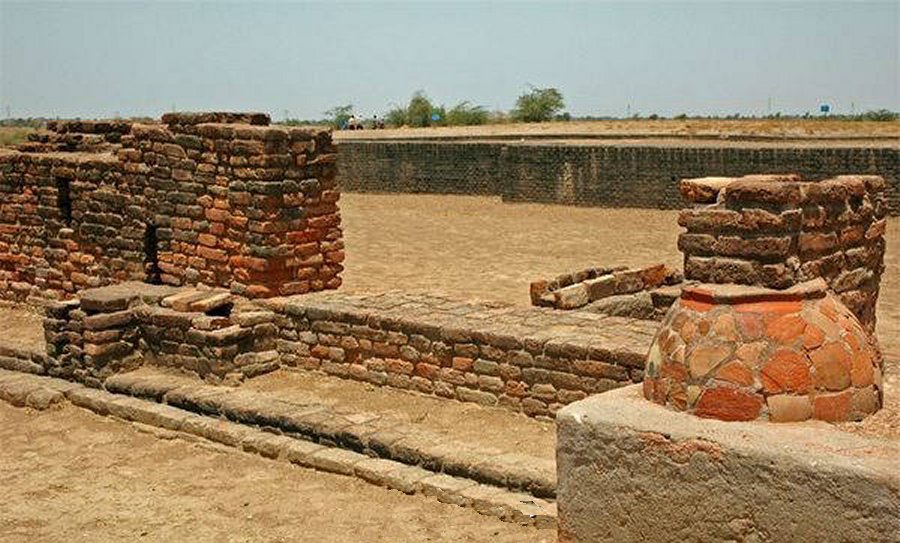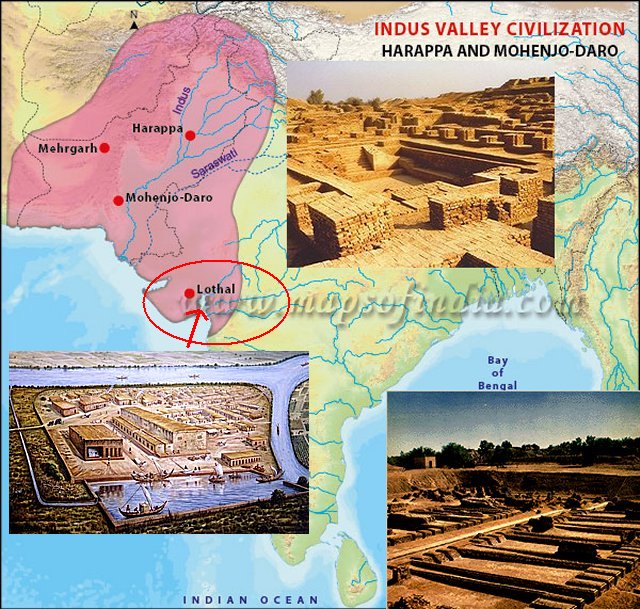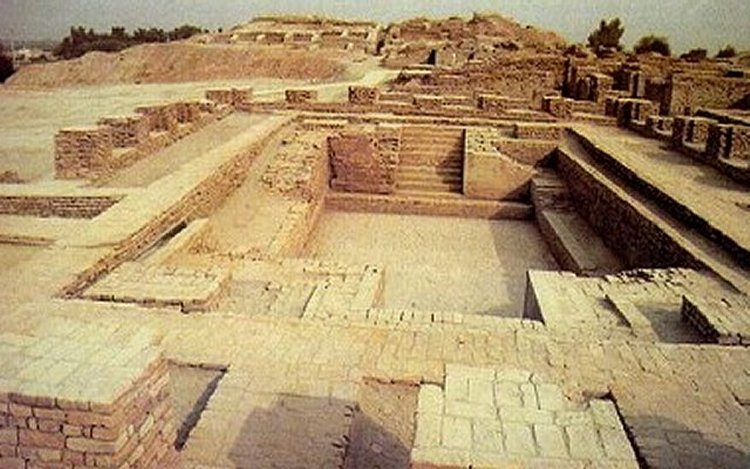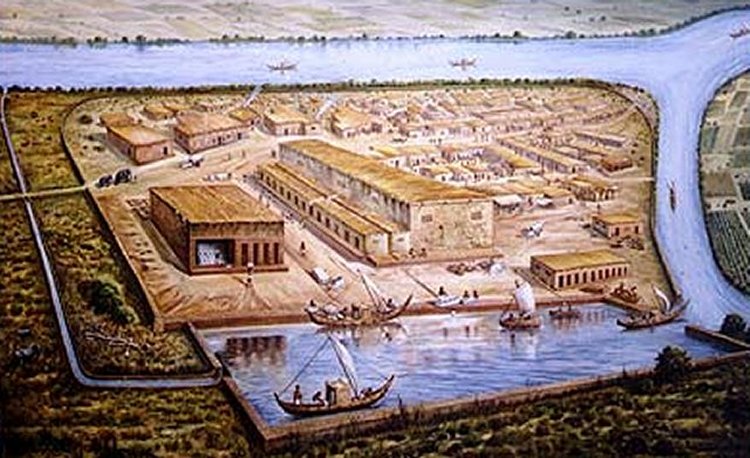Lothal – ‘City of Dead’ – One Of The Most Prominent Ancient Places In Danger To Be Forgotten
A. Sutherland - AncientPages.com - Throughout history, abandoned ancient places with fantastic history have always fascinated people. Unfortunately, many of these places are now forgotten, neglected, or destroyed.
Lothal, one of the most prominent cities of the ancient Indus Valley Civilization, located in the Bhal region of the modern state of Gujarat, in the western part of India, is just one such example.
About 80km southwest of Ahmedabad, the city that stood at this archaeological site 4500 years ago, was one of the most important of the Indus Valley civilization, which is now Pakistan's. Excavations have revealed the world's oldest known artificial dock connected to an ancient course of the Sabarmati River.
Lothal also has more. Other features include the acropolis, the lower town, the bead factory, the warehouses, and the drainage system.
Loth and thal, which in Gujarati means 'the mound of the dead.' The city was inhabited during 3700 BCE and was a thriving trading port. The excavation was started from 13 February 1955 to 19 May 1960 by the Archaeological Survey of India (ASI) to unearth ancient cities.
Archaeologists believe that the city was a part of a central river system on the old trade route from Sindh to Saurashtra in Gujarat. Excavations here have offered the most significant number of antiquities in the archaeology of modern India.
Lothal, which means 'The City of Dead,' is an old city dating back to the 4,400year-old Harappan civilization and one of the few known ports on an ocean.
Lothal has initially been the site for the lustrous Red Ware culture, associated with the post-Rigvedic Vedic civilization and named for its mica-related pottery.
The people of Lothal worshipped a fire god, which could be the horned deity depicted on ancient seals.
The city that developed as the most important port and a center of the bead industry, gems, and valuable ornaments flourished until 1900 BC. These products reached the far corners of West Asia and Africa.
The massive dockyard, which was the world's earliest known, had 37 meters from east to west and nearly 22 meters from north to south. It made Lothal famous. The dock was probably the most outstanding work of maritime architecture before the birth of Christ. It was the earliest known dock found in the world, equipped to berth and service ships.
It has been speculated that Lothal engineers studied tidal movements and their effects on brick-built structures since the walls were constructed of kiln-burnt bricks. This knowledge also enabled them to select Lothal's location in the first place, as the Gulf of Khambhat has the highest tidal strength, and ships can be sluiced through flow tides in the river tributaries or creeks.
Modern oceanographers have observed that the Harappans must have possessed excellent knowledge relating to tides to build such a dock on the ever-shifting course of the Sabarmati. Their knowledge must have also included exemplary hydrography and maritime engineering. It is awe-inspiring because these technologies were used 4000 years ago.
The town was divided into blocks of approx two meter-high (approx 6 ft) platforms of kiln baked and dried bricks, each consisting of 20–30 houses of thick mud and brick walls. The dockyard's location was away from the main river to avoid the deposition of silt.
The engineers built a trapezoidal structure with north-south arms of 21.8 meters (71.5 ft) and east-west components of 37 meters (121 ft).
The basin could have served as an irrigation tank, for the estimated original dimensions of the "dock" are not large enough, by modern standards, to house ships and conduct much traffic.
It connected the city to an ancient course of the Sabarmati river on the trade route between Harappan cities in Sindh and the peninsula of Saurashtra when the surrounding Kutch desert of today was a part of the Arabian Sea.
Surrounded by a massive brick wall, which was probably used for flood protection, Lothal was safe. The southeastern quadrant takes the form of a great platform of brick with earth filling, rising to a height of about 13 feet (4 meters). It was built a series of other smaller platforms with intersecting air channels, reminiscent of the granary at Mohenjo-daro, with overall dimensions of about 159 by 139 feet (48 by 42 meters).
Then, a great flood resulted in the gradual decline of Lothal.
While there is still no sure reason for the decline of the city, archaeological evidence gathered by the Archaeological Survey of India appears to point to natural catastrophes, mainly floods and storms, as the source of Lothal's downfall. The worst consequence was the shift in the river's course, cutting off access to the ships and dock.
Now, the city's remnants are being obliterated. However, the ancient site still attracts visitors, particularly school and college students. Still, no guards protect the ancient ruins, and there are no qualified guides to show the visitor around Lothal.
Tourists trample the structure with little concern for its fragility, and it is common to witness people stealing archaeological remains from the site. Lothal's cemetery is no longer accessible because of wild growth on the approach. The cemetery houses and two skeletons were found during excavations at the site, carried out between 1955 and 1962.
The site is overrun by weeds, adding to the general air of neglect and chaos.
According to ASI officials, 'shortage of funds has lead to staff inadequacy, which has affected even routine maintenance tasks like clearing of weeds. Now, the gateman of the museum has to run to the historical Lothal dock to caution visitors against moving on the precarious structure.'
Money problems prevent officials from carrying out further excavations.
Written by – A. Sutherland AncientPages.com Staff Writer
Copyright © AncientPages.com All rights reserved. This material may not be published, broadcast, rewritten or redistributed in whole or part without the express written permission of AncientPages.com
Expand for references
More From Ancient Pages
-
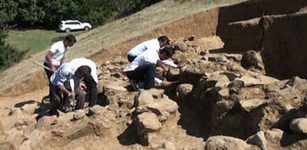 New Findings In Ancient Palidli Necropolis, Agdam Azerbaijan
Civilizations | Sep 24, 2015
New Findings In Ancient Palidli Necropolis, Agdam Azerbaijan
Civilizations | Sep 24, 2015 -
 On This Day In History: Simon Fraser – The Last Man In Britain To Be Executed On Tower Green, London – On Apr 9, 1747
News | Apr 9, 2017
On This Day In History: Simon Fraser – The Last Man In Britain To Be Executed On Tower Green, London – On Apr 9, 1747
News | Apr 9, 2017 -
 World’s First Diva Was Livia – Wife Of Emperor Augustus
Ancient History Facts | Aug 2, 2016
World’s First Diva Was Livia – Wife Of Emperor Augustus
Ancient History Facts | Aug 2, 2016 -
 Gold Treasures Of Ancient King Discovered In North America Create Historical Problems
Civilizations | Jun 29, 2018
Gold Treasures Of Ancient King Discovered In North America Create Historical Problems
Civilizations | Jun 29, 2018 -
 Galileo Galilei Wrote A Controversial Astronomical Treatise Using A Pseudonym
News | Oct 6, 2022
Galileo Galilei Wrote A Controversial Astronomical Treatise Using A Pseudonym
News | Oct 6, 2022 -
 Intriguing Sumerian Clay Tokens – An Ancient ‘Book Keeping’ System Used Long After Writing Appeared
Artifacts | Jul 8, 2017
Intriguing Sumerian Clay Tokens – An Ancient ‘Book Keeping’ System Used Long After Writing Appeared
Artifacts | Jul 8, 2017 -
 Mystery Of The 1,700-Year-Old ‘Salt’ Mummy With Long White Hair
Featured Stories | Sep 14, 2016
Mystery Of The 1,700-Year-Old ‘Salt’ Mummy With Long White Hair
Featured Stories | Sep 14, 2016 -
 Mead: Secret Drink Of The Vikings And Gods – Was It An Ancient Antibiotic?
News | Feb 21, 2016
Mead: Secret Drink Of The Vikings And Gods – Was It An Ancient Antibiotic?
News | Feb 21, 2016 -
 Shengavit Of Kura Araxes Culture: One Of Armenia’s Historical Sites Inhabited Since At Least 3200 BC
Civilizations | Apr 13, 2021
Shengavit Of Kura Araxes Culture: One Of Armenia’s Historical Sites Inhabited Since At Least 3200 BC
Civilizations | Apr 13, 2021 -
 Seppuku: Ancient Suicide Ritual That Guaranteed Honorable Death Instead For Life In Shame
Ancient Traditions And Customs | Mar 8, 2018
Seppuku: Ancient Suicide Ritual That Guaranteed Honorable Death Instead For Life In Shame
Ancient Traditions And Customs | Mar 8, 2018 -
 On This Day In History: The Battle Of Fulford Was Fought – On Sep 20, 1066 AD
News | Sep 20, 2015
On This Day In History: The Battle Of Fulford Was Fought – On Sep 20, 1066 AD
News | Sep 20, 2015 -
 Legend Of Bochica And Mysterious Ancient Stone Structures In Colombia
Featured Stories | Jun 5, 2016
Legend Of Bochica And Mysterious Ancient Stone Structures In Colombia
Featured Stories | Jun 5, 2016 -
 Norse Legend Of Hero Sigmund And The Magical Sword In The Branstock Tree
Featured Stories | Jun 25, 2016
Norse Legend Of Hero Sigmund And The Magical Sword In The Branstock Tree
Featured Stories | Jun 25, 2016 -
 Unknown 8,000-Year-Old Human Settlement With A Rock-Cut Temple, Altar And Inscriptions Discovered In Al-Faw, Saudi Arabia
Archaeology | Aug 3, 2022
Unknown 8,000-Year-Old Human Settlement With A Rock-Cut Temple, Altar And Inscriptions Discovered In Al-Faw, Saudi Arabia
Archaeology | Aug 3, 2022 -
 Nurikabe: Trickster That Manifests Itself As Invisible, Impassable Wall In Japanese Old Beliefs
Featured Stories | Oct 21, 2019
Nurikabe: Trickster That Manifests Itself As Invisible, Impassable Wall In Japanese Old Beliefs
Featured Stories | Oct 21, 2019 -
 DNA Shows First Scandinavians Followed Two Distinct Migration Routes
Archaeology | Jan 11, 2018
DNA Shows First Scandinavians Followed Two Distinct Migration Routes
Archaeology | Jan 11, 2018 -
 Ancient Sound Of Stones – Acoustics At Stonehenge Tested By Scientists
Ancient Technology | Aug 29, 2020
Ancient Sound Of Stones – Acoustics At Stonehenge Tested By Scientists
Ancient Technology | Aug 29, 2020 -
 On This Day In History: Alexander The Great Died In Babylon – On June 11, 323 BC
News | Jun 11, 2016
On This Day In History: Alexander The Great Died In Babylon – On June 11, 323 BC
News | Jun 11, 2016 -
 Peace Of Callias – A Treaty That Ended The Greco-Persian Wars
Ancient History Facts | May 15, 2019
Peace Of Callias – A Treaty That Ended The Greco-Persian Wars
Ancient History Facts | May 15, 2019 -
 Blame The Neanderthals For Your Lower Back Pain – Scientists Say
Archaeology | Mar 8, 2022
Blame The Neanderthals For Your Lower Back Pain – Scientists Say
Archaeology | Mar 8, 2022

